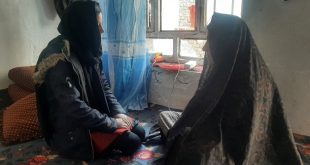NEW YORK, Dec 08 (IPS) – After ten years and not using a sturdy La Niña climate phenomenon in Colombia, the local weather sample, coupled with the COVID-19 pandemic, may create a vacuum in meals manufacturing and provide. Multilateral organizations, together with the Colombian authorities, are attempting to implement measures to scale back malnutrition danger. Nonetheless, the inhabitants is already overwhelmed by a yr of struggles which have deepened socio-economic variations.
Beginning in March this yr with the COVID-19 pandemic and adopted by the hurricane IOTA in November, Colombia has seen its malnutrition ranges rise dramatically. The pandemic has left over 37,000 deaths and a rise of 6.four% in unemployment in October in comparison with the identical month in 2019. (This proportion does not account for casual staff—47% of the inhabitants, in keeping with the nation’s statistics division DANE).
“[The socio-economic crisis] is coherent with a deepening poverty state of affairs as highlighted by the most recent official figures—35.7% of Colombian households have been in poverty in 2019, already some 660,000 greater than in 2018,” says Lorena Peña, the communications coordinator for the World Meals Programme (WFP) in Bogota to IPS, going again to the numbers earlier than the pandemic.
These knowledge factors are more likely to enhance—particularly in La Guajira, Norte de Santander and Bolivar,—because the nation prepares for the anticipated La Niña-caused heavy rains, which the Colombian Climate Institute (IDEAM) estimates to final till Might of subsequent yr.
In accordance with the World Meteorological Group (WMO), La Niña is a cooling of ocean floor temperatures that generates winds and rainfalls within the equatorial Pacific Ocean. In 2020-2021, the phenomenon is anticipated to be average to sturdy, because it was within the interval 2010-2011. That point, La Niña claimed 300 lives and left an equal variety of individuals injured.
This yr, the phenomenon may result in landslides, floods, ailments, and pests, say Jorge Mahecha, communications coordinator, and Martina Salvo, in command of agricultural resilience, on the Meals and Agriculture Group (FAO) of the United Nations in Bogota to IPS.
A downside in Colombia’s vitamin achievements
Previously 5 years, Colombia has established itself because the main middle-income nation in sustainable agriculture and meals vitamin, in keeping with the Food Sustainability Index, developed by the Barilla Center for Food & Nutrition and the Economist Intelligence Unit.
Colombia achieved high performances in using land, air, and water within the rating. It was second, out of 23 counties, in tackling dietary challenges, comparable to undernutrition and hidden starvation, notes the report. It was additionally effectively above a few of its friends, comparable to Mexico, relating to meals vitamin indexes.
Nonetheless, the pandemic has meant a downside for Colombia. Earlier than La Niña, WFP was already estimating that 52.6% of the inhabitants had issues accessing meals “of which not less than some three.5 million individuals severely meals insecure,” informed Peña from WFP to IPS. She added that meals insecurity was extra prevalent in Arauca, La Guajira, Norte de Santander, and Bolivar.
Now that La Niña is reaching Colombia, meals safety may additional deteriorate, relying on the depth of the climate sample.
“The La Niña phenomenon tends to be related to heavy rainfall in Colombia, however this does not essentially imply that the crops will probably be harmed,” says Carmen González Romero, nation supervisor for Colombia within the ACToday (Adapting agriculture to Local weather In the present day for Tomorrow) undertaking. The undertaking is led by the Worldwide Analysis Institute, a part of the Earth Institute at Columbia College. “If the depth of the rain is excessive sufficient, sure, it may destroy them.”
The influence may very well be felt all through the meals manufacturing system. “On the one hand, heavy rains may destroy the crops of subsistence farmers. This is able to not solely influence their entry to meals within the current but in addition within the close to future threatening their primary grain reserves,” explains González Romero. “On the opposite, massive producers, related to a guild and better technological capability, may additionally see their enterprise endangered. This is able to generate a vicious cycle, laborers that work for them would lose their jobs and their earnings. Moreover, heavy rains may influence civil infrastructure, limiting the entry to markets, that are important for meals safety within the nation.”
The FAO predicts that among the many crops to be impacted by the torrential rains are the “pancoger crops comparable to plantain, corn, yuca, and beans.” Different crops that Colombia exports, comparable to cacao and occasional, is also harmed by the altering climate forecasts, add Mahecha and Salvo, from FAO.
Farmers and establishments put together for La Niña
The Colombian authorities, its climate establishments, and farmers must face the implications of La Niña quickly.
Requested how farmers can put together themselves for climate patterns, González Romero responds: “Farmers want entry to local weather providers to optimize crop administration and assets.” She provides that their capability to organize themselves for climate patterns additionally depends upon their financial assets and the time they’ve to organize.
Furthermore, explains González Romero, there are monetary devices for local weather danger transfers, comparable to index-based insurances, that might mitigate the hurt of antagonistic local weather occasions, be it floods or droughts. “They exist, however they aren’t broadly out there in Colombia, nor South America.”
At an institutional degree, the federal government may create forecast-based financing methods that will set off money transfers to impacted staff if droughts or floods hurt their crops, notes González Romero.
Multilateral organizations are additionally getting ready for La Niña whereas they nonetheless attempt to alleviate the pandemic’s penalties. To make sure that malnutrition isn’t widespread, the FAO argues that meals provide methods ought to be prioritized. Nonetheless, some roads have change into unusable, tells Peña from the WFP to IPS, including that, for instance, in-kind meals transport to Alta Guajira was delayed in October.
The inhabitants that’s anticipated to be impacted by La Niña is probably the most susceptible, say the FAO representatives, including that the identical sector has additionally suffered probably the most in the course of the pandemic.
The WFP is mobilizing “cash-based transfers the place doable, and in-kind can also be deliberate for areas the place markets aren’t absolutely useful,” says the establishment. They’re working in Arauca, Bolívar, Chocó, La Guajira, and Norte de Santander, the place meals insecurity is widespread.
On its half, UNICEF is ready to supply dietary dietary supplements to kids below 5 years of age within the websites the place WFP delivers meals assist.
As establishments and farmers attempt to grapple with the potential of La Niña, stakeholders concern the climate phenomenon will deepen the socioeconomic variations already sharpened by the pandemic—particularly in rural areas.
Nonetheless, it is onerous to foretell the implications of the phenomenon till it hits the nation. “We’ve got but to see what La Niña brings,” concluded González Romero on a cautionary be aware.
Follow @IPSNewsUNBureau
Follow IPS New UN Bureau on Instagram
© Inter Press Service (2020) — All Rights ReservedOriginal source: Inter Press Service
 Top Naija News: Nigerian News, Breaking News Nigeria and World News Top Naija News is a daily news publication in Nigeria, delivering the latest breaking news in Nigeria and around the world.
Top Naija News: Nigerian News, Breaking News Nigeria and World News Top Naija News is a daily news publication in Nigeria, delivering the latest breaking news in Nigeria and around the world.




